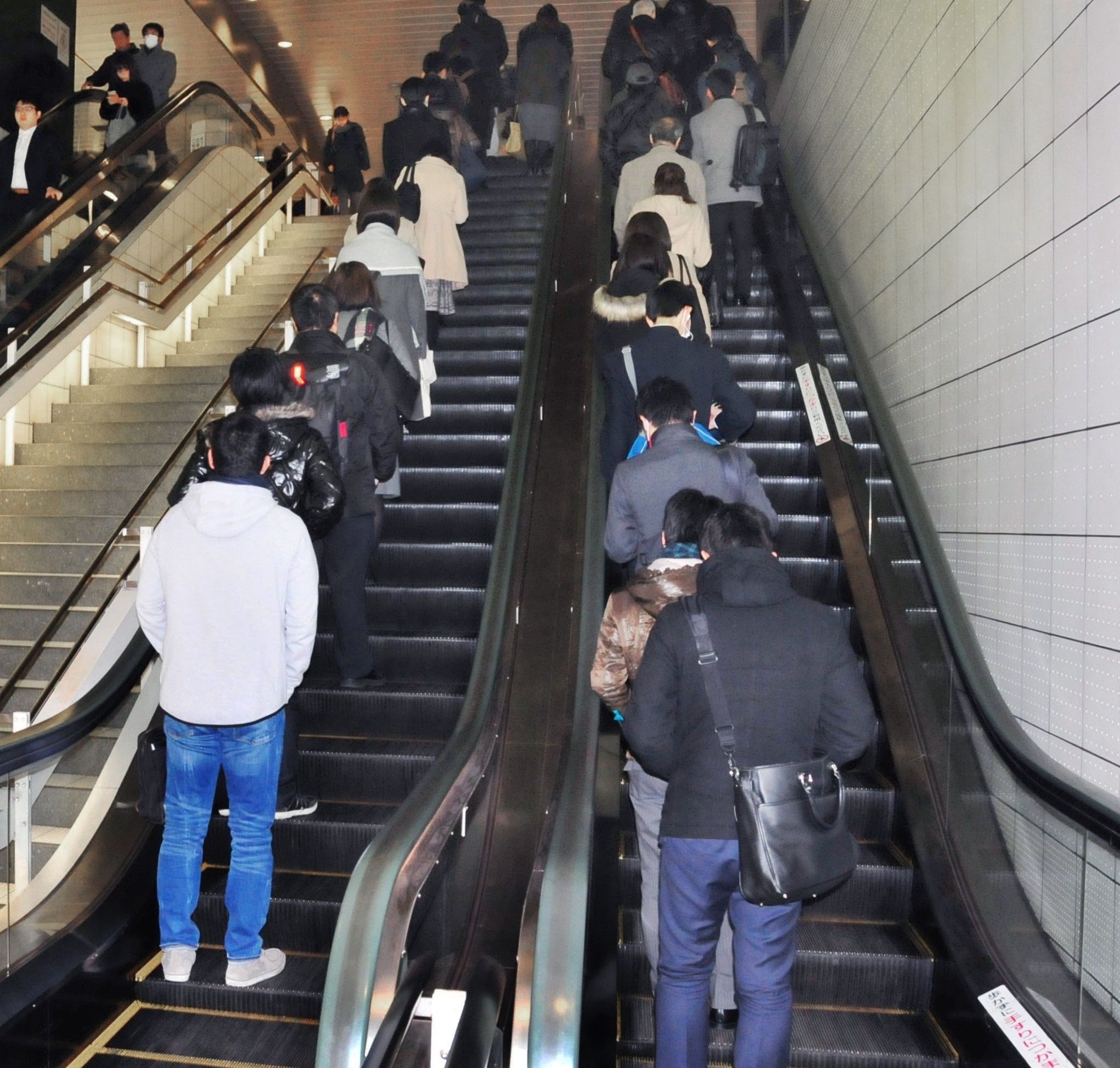Japan’s Mysterious Escalator Manners/エスカレーター「片側空け」の謎
Japan’s Mysterious Escalator Manners: Railroad Companies Urge Passengers to Stand in Two Lines after a Series of Accidents
March 8th is Escalator Day in Japan, where the country’s first escalator was launched for a test run in Tokyo on this day in 1914. To commemorate this event, Your Special Mission News Crew has investigated a simple question from a woman from Fukuoka City who commutes to and from work by subway. She asked: “Escalators are always crowded. Users invariably leave the right side open, but wouldn't it be more efficient to just stand on both sides of the elevator steps?” Keeping one side of the escalator open has become an established etiquette, but what is the actual situation?
■
Tenjin-minami Subway Station bustles with commuters. Observing those on the escalators, many people line up on the left while people who are in a hurry rush up the right side. This is a familiar sight, but the sign nearby encouraged otherwise: “Please hold on to the handrail and stand in two lines.”
The stationmaster explains that leaving one side open is a not desirable way use the escalator. “For everyone’s safety, it is better to stand on both sides.”

The escalators at Tenjin-minami Subway Station in Japan. Many people stand on the left side for others who are in a rush to pass on the right. Chuo Ward, Fukuoka City.
There is a reason behind this policy. Back in 2016, a woman in her fifties was injured at this station when she was knocked over by a man who was running the escalator. According to the Fukuoka City Transportation Bureau, such tripping or falling accidents have occurred 28 to 48 times every year since 2011. JR Kyushu has also been urging people not to walk on escalators since 2010.
According to the Japan Elevator Association, the steps on a standard escalator are about 20 cm to 23 cm tall and 1 m wide. On the other hand, stairways in public facilities are required by the Building Standard Law to be less than 18 cm tall and more than 1.4 m wide. “Escalators are not designed for people to walk on,” says a spokesperson for the association. It is, in fact, dangerous to walk on them.
■■
Leaving one side open on escalators is a common sight at department stores, too, but what was the history behind this behavior? “As Japan became more globalized, the perception expanded that the people should learn Western manners,” says Masakazu Toki, a professor at Edogawa University who researches escalator culture.
According to Professor Toki, the idea to leave one side open was first promoted at London stations around 1944, and this later spread throughout Europe and North America. At the time, this was not for etiquette, but rather, intended for better transport efficiency. The custom was introduced to Japan by Hankyu Railway inside Umeda Station, before Expo ’70 in Osaka. This was around the time when Japan was overcoming its defeat in WWII and growing rapidly into an economic power. The practice became widely accepted through the mentality that the Japanese must “learn manners that are comparable to that of foreigners.”
By the 90s, escalators had been installed in most subway stations in central Tokyo. Newspapers at the time introduced the custom as the “New Order of Escalators,” which spread across the nation. This was characterized by the different rules according to each region; the right was kept open in Tokyo, while the Kansai region kept the left open for walkers. Professor Toki says, “The efficiency-oriented value to keep one side open for those in a hurry fit with the times.”
It is difficult to change habits, once it is believed to be good manners. Tomio Kinoshita, professor emeritus at Kyoto University with extensive knowledge on herd behavior, states that “It is difficult to win the understanding of people without evidence such as statistics on safety improvements.”
エスカレーター「片側空け」の謎 鉄道会社は「2列で乗って」 転倒事故相次ぐ
3月8日は「エスカレーターの日」。1914年、日本初のエスカレーターが東京で試験運転された日だ。地下鉄で通勤する福岡市の20代女性から「エスカレーターがいつも混雑する。利用者は必ず右側1列を空けるが、両側に並べばいいのでは」と、素朴な疑問が特命取材班に寄せられた。マナーとして定着している「片側空け」。実際はどうなの?
■
通勤客でごった返す福岡市営地下鉄天神南駅。エスカレーターを見ると、多くの人は左側に並び、急ぐ人が空いた右側を駆け上がっていく。見慣れた光景だが、傍らには看板があった。「手すりにつかまり、2列で乗りましょう」
同駅によると、片側空けは望ましい利用方法ではないという。「安全のためには2列で乗るのがいい」と江利稔駅長は話す。
理由がある。同駅では2016年、エスカレーターに乗っていた50代女性が後ろから走ってきた男とぶつかって転倒する事故が起きた。市交通局によると、こうした転倒・落下事故は11年度以降、市営地下鉄で年間28~48件に上る。JR九州や西日本鉄道も10年ごろから、歩行禁止を呼び掛けている。
日本エレベーター協会(東京)によると、通常のエスカレーターは段差20~23センチ、幅1メートル程度。これに対し、公共施設の階段は建築基準法で段差18センチ以下、幅1・4メートル以上と定められている。「設計上、エスカレーターは歩くことを想定していない」と言う。歩くことは危険なのだ。
■■
片側空けは百貨店などでもよく見掛ける。どんな由来があるのだろう。「国際化が進む過程で、欧米式マナーを学ぶべきだという価値観があって広まった」。エスカレーター文化を研究する江戸川大学の斗鬼正一教授が解説する。
斗鬼教授によると、片側空けは1944年ごろのロンドンの駅で推奨され、欧米各国に広まった。当時はマナーというより、その方が輸送効率が高まると考えられていた。日本では70年の大阪万博を控え、阪急電鉄が梅田駅構内で呼び掛けたのが始まり。折しも敗戦から立ち直り、経済大国に躍進していく時代。「外国人に恥ずかしくないマナーを」という意識が普及を後押ししたという。
90年ごろには、東京都心の地下鉄の駅でも定着。当時の新聞は「エスカレーター『新秩序』」と紹介し、やがて全国に普及した。東京の右空けに対し、関西は左空けというのが特徴だ。斗鬼教授は「急ぐ人を優先し、1列空けるという効率重視の価値観が時代にマッチした」と分析する。
いったんマナーと思い込んでしまうと、習慣を変えるのは難しい。群衆行動に詳しい京都大学の木下冨雄名誉教授は「どれほど安全性が向上するかなどの根拠を示さないと、理解を得にくいのではないか」と話した。
Congratulations @westjapandaily! You have completed some achievement on Steemit and have been rewarded with new badge(s) :
Click on any badge to view your own Board of Honor on SteemitBoard.
To support your work, I also upvoted your post!
For more information about SteemitBoard, click here
If you no longer want to receive notifications, reply to this comment with the word
STOP